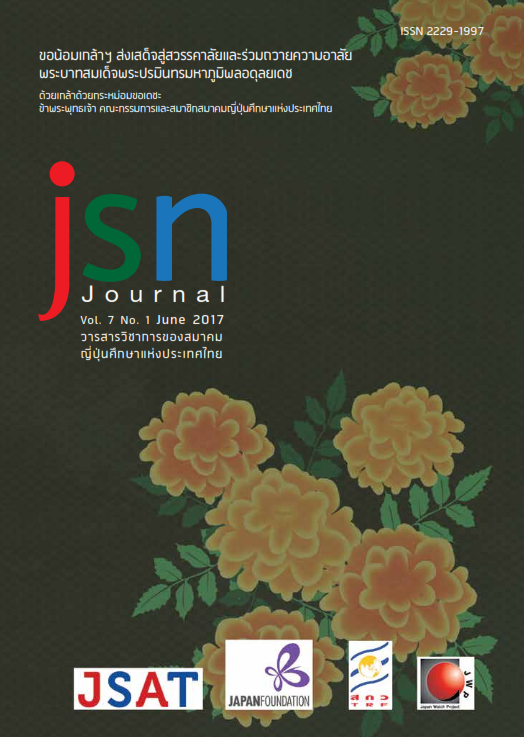Katakana Instruction for Thai Learners: A Case Study of Vocational College Students
Main Article Content
Abstract
The objective of this research was to study the achievement and effectiveness of learning Katakana on the part of Thai high school students when using the association method and active learning, which promotes active involvement, and to study the aspect of motivation and its effectiveness in the learning process. The sample group was a group of freshmen from Saowapa Vocational College (Vocational Certificate Program) that had selected Japanese studies as their elective subject and had no background knowledge of any of the Japanese characters (Hiragana, Katakana, and Kanji). The control group of 40 students was taught Katakana characters by using Katakana flashcards solely, while the experimental group of the same number was taught by means of the association method, and the students were urged to actively participate throughout the session. The methods employed in this research can be apportioned into 4 parts: 1) a pre-course test and a post-course test; 2) a Katakana alphabet test after a period of one month; 3) a questionnaire on the students’ opinions and expectations from Japanese language study; and, 4) an interview with the sample group regarding their perception of the classes as well as their views on the association method and their active involvement. The research findings indicated the effectiveness of the association method when applied to the teaching and learning of the Katakana characters as the result of both the post-course test and the test after one month of the students in the experimental group was significantly higher than that of the students in the control group. The findings also implied that the employment of the association method, along with the promotion of active involvement, helped to motivate the students in the learning process.
Article Details
ข้อความและข้อคิดเห็นต่างๆ ในบทความเป็นของผู้เขียนบทความนั้นๆ ไม่ใช่ความเห็นของกองบรรณาธิการหรือของวารสาร jsn Journal
References
สุณีย์รัตน์ เนียรเจริญสุข. (2557). การสอนตัวอักษรฮิรางานะด้วยวิธีคิดเชื่อมโยง. วารสารเจแปน ฟาวน์เดชั่นกรุงเทพฯ 11, 101-110.
Atkinson, R. C. (1975). Mnemotechnics in second-language learning. Retrieved March, 25, 2015, from http://www.rca.ucsd.edu/selected_papers/12_ Mnemotechnics%20in%20second%20language%20learning.pdf
Keller, J. M. (1984). The use of the ARCS model of motivation in teacher training. Retrieved March 25, 2015, from https://learn.vccs.edu/bbcswebdav/institution/SO/IDOL/ Unit%201%20-%20Analyze%20Learners/ARCS%20Model%20of%20Motivational% 20Design.pdf
Kondo, S. (2011). Lexical Acquisition in Japanese as a Second Language: The Effect of Visual and Written Mnemonic Cues on Memorization of Hiragana. Retrieved March 25, 2015, from http://eastasianstudies.research.yale.edu/JLTANE/JLTANEhome.phpdatabase.
Matsunaga, S. (2003). Effects of Mnemonics on Immediate and Delayed Recalls of Hiragana be Learners of Japanese as a Foreign Language. Retrieved March 25, 2015, from http://dl.ndl.go.jp/view/download/digidepo_8221112_po_019__040.PDF?contentNo=1&alternativeNo=
Quackenbush, H. C., Ohso, M. (1983). Hiragana in 48 Minutes. Canberra, A.C.T. Australia: Curriculum Development Centre.
Quackenbush, H. C. (1999). HIRAGANA/KATAKANA in 48 minutes: teacher guide. Melbourne, Vic. Australia: Curriculum Corporation.
梅田康子・水田澄子・鈴木庸子.(2009).「韓国人高校生のための IS 連想法ひらがな学習カードの評価―記憶方略および ARCS 動機付けモデルの観点から― 」 『言語と 文化』 愛知大学, 20号, 121-139.
カッケンブッシュ寛子・中條和光・長友和彦・多和田眞一郎(1989).「50 分ひらがな 導入法 :『連想法』 と 『色つきカード法』の比較」, 『日本語教育』 69 号, 日本語教育学会, 147-162.
プラパー・セントーンスック・三浦多佳史・渋谷実希・熊野七絵(2011). 『こはるといっしょにひらがなわぁ~い』 TPA Press.


